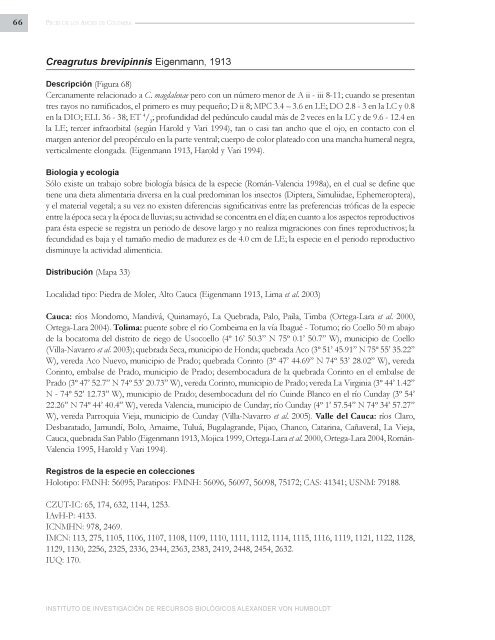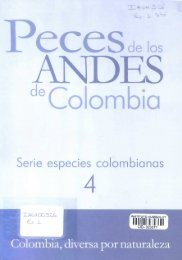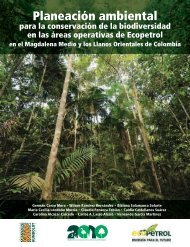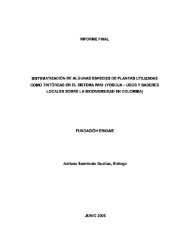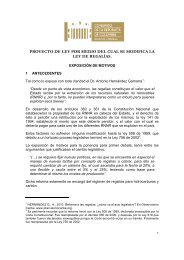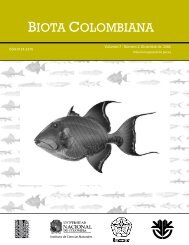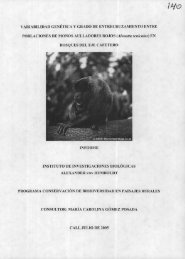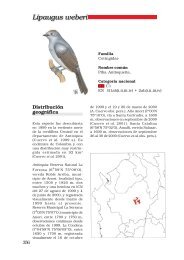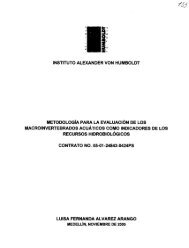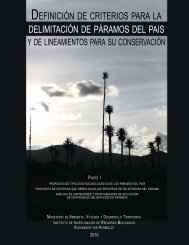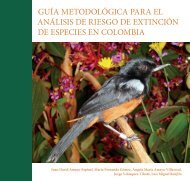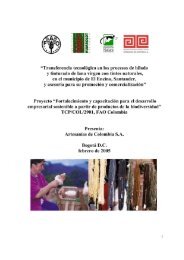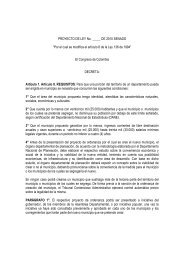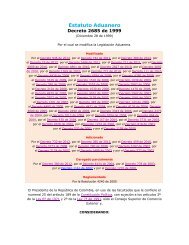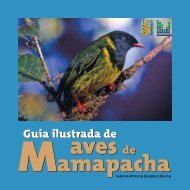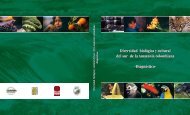PECES DE LOS ANDES DE COLOMBIA - Instituto de Investigación ...
PECES DE LOS ANDES DE COLOMBIA - Instituto de Investigación ...
PECES DE LOS ANDES DE COLOMBIA - Instituto de Investigación ...
You also want an ePaper? Increase the reach of your titles
YUMPU automatically turns print PDFs into web optimized ePapers that Google loves.
66 <strong>PECES</strong> <strong>DE</strong> <strong>LOS</strong> AN<strong>DE</strong>S <strong>DE</strong> <strong>COLOMBIA</strong><br />
Creagrutus brevipinnis Eigenmann, 1913<br />
Descripción (Figura 68)<br />
Cercanamente relacionado a C. magdalenae pero con un número menor <strong>de</strong> A ii - iii 8-11; cuando se presentan<br />
tres rayos no ramificados, el primero es muy pequeño; D ii 8; MPC 3.4 – 3.6 en LE; DO 2.8 - 3 en la LC y 0.8<br />
en la DIO; ELL 36 - 38; ET 4 / 3 ; profundidad <strong>de</strong>l pedúnculo caudal más <strong>de</strong> 2 veces en la LC y <strong>de</strong> 9.6 - 12.4 en<br />
la LE; tercer infraorbital (según Harold y Vari 1994), tan o casi tan ancho que el ojo, en contacto con el<br />
margen anterior <strong>de</strong>l preopérculo en la parte ventral; cuerpo <strong>de</strong> color plateado con una mancha humeral negra,<br />
verticalmente elongada. (Eigenmann 1913, Harold y Vari 1994).<br />
Biología y ecología<br />
Sólo existe un trabajo sobre biología básica <strong>de</strong> la especie (Román-Valencia 1998a), en el cual se <strong>de</strong>fine que<br />
tiene una dieta alimentaria diversa en la cual predominan los insectos (Diptera, Simuliidae, Ephemeroptera),<br />
y el material vegetal; a su vez no existen diferencias significativas entre las preferencias tróficas <strong>de</strong> la especie<br />
entre la época seca y la época <strong>de</strong> lluvias; su actividad se concentra en el día; en cuanto a los aspectos reproductivos<br />
para ésta especie se registra un periodo <strong>de</strong> <strong>de</strong>sove largo y no realiza migraciones con fines reproductivos; la<br />
fecundidad es baja y el tamaño medio <strong>de</strong> madurez es <strong>de</strong> 4.0 cm <strong>de</strong> LE; la especie en el periodo reproductivo<br />
disminuye la actividad alimenticia.<br />
Distribución (Mapa 33)<br />
Localidad tipo: Piedra <strong>de</strong> Moler, Alto Cauca (Eigenmann 1913, Lima et al. 2003)<br />
Cauca: ríos Mondomo, Mandivá, Quinamayó, La Quebrada, Palo, Paila, Timba (Ortega-Lara et al. 2000,<br />
Ortega-Lara 2004). Tolima: puente sobre el río Combeima en la vía Ibagué - Totumo; río Coello 50 m abajo<br />
<strong>de</strong> la bocatoma <strong>de</strong>l distrito <strong>de</strong> riego <strong>de</strong> Usocoello (4º 16’ 50.3’’ N 75º 0.1’ 50.7’’ W), municipio <strong>de</strong> Coello<br />
(Villa-Navarro et al. 2003); quebrada Seca, municipio <strong>de</strong> Honda; quebrada Aco (3º 51’ 45.91’’ N 75º 55’ 35.22’’<br />
W), vereda Aco Nuevo, municipio <strong>de</strong> Prado; quebrada Corinto (3º 47’ 44.69’’ N 74º 53’ 28.02’’ W), vereda<br />
Corinto, embalse <strong>de</strong> Prado, municipio <strong>de</strong> Prado; <strong>de</strong>sembocadura <strong>de</strong> la quebrada Corinto en el embalse <strong>de</strong><br />
Prado (3º 47’ 52.7’’ N 74º 53’ 20.73’’ W), vereda Corinto, municipio <strong>de</strong> Prado; vereda La Virginia (3º 44’ 1.42’’<br />
N - 74º 52’ 12.73’’ W), municipio <strong>de</strong> Prado; <strong>de</strong>sembocadura <strong>de</strong>l río Cuin<strong>de</strong> Blanco en el río Cunday (3º 54’<br />
22.26’’ N 74º 44’ 40.4’’ W), vereda Valencia, municipio <strong>de</strong> Cunday; río Cunday (4º 1’ 57.54’’ N 74º 34’ 57.27’’<br />
W), vereda Parroquia Vieja, municipio <strong>de</strong> Cunday (Villa-Navarro et al. 2005). Valle <strong>de</strong>l Cauca: ríos Claro,<br />
Desbaratado, Jamundí, Bolo, Amaime, Tuluá, Bugalagran<strong>de</strong>, Pijao, Chanco, Catarina, Cañaveral, La Vieja,<br />
Cauca, quebrada San Pablo (Eigenmann 1913, Mojica 1999, Ortega-Lara et al. 2000, Ortega-Lara 2004, Román-<br />
Valencia 1995, Harold y Vari 1994).<br />
Registros <strong>de</strong> la especie en colecciones<br />
Holotipo: FMNH: 56095; Paratipos: FMNH: 56096, 56097, 56098, 75172; CAS: 41341; USNM: 79188.<br />
CZUT-IC: 65, 174, 632, 1144, 1253.<br />
IAvH-P: 4133.<br />
ICNMHN: 978, 2469.<br />
IMCN: 113, 275, 1105, 1106, 1107, 1108, 1109, 1110, 1111, 1112, 1114, 1115, 1116, 1119, 1121, 1122, 1128,<br />
1129, 1130, 2256, 2325, 2336, 2344, 2363, 2383, 2419, 2448, 2454, 2632.<br />
IUQ: 170.<br />
INSTITUTO <strong>DE</strong> INVESTIGACIÓN <strong>DE</strong> RECURSOS BIOLÓGICOS ALEXAN<strong>DE</strong>R VON HUMBOLDT


